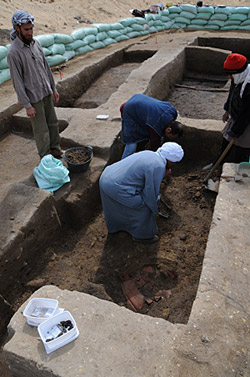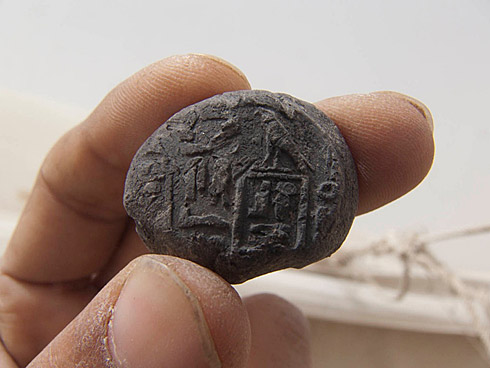Using Sealing Fragments to Hear Ancient Voices
by John Nolan
 As strange as it may sound, much of our understanding of our excavations at Giza, rests on how we interpret small, broken chunks of clay that come out of the site. These fragments come from sealings, which were daubs of refined clay that were attached to doors, jars, boxes, and papyrus documents. They were often pressed down over a knot on a rope or cord when wet. Sometimes while it was still wet, the person who owned the item would roll a cylinder seal, inscribed with texts or pictures across the front of the sealing leaving behind an impression of the seal’s inscription. This sealing would then dry rock hard. Should anyone remove the sealing, it would either pop off or break. Either way, the owner would know that someone had tampered with their door, jar or box. Mopre often than not, the seal owner would notice that the sealing was intact and would remove it himself and replace it later. In this way, life in our ancient site would generate hundreds and thousands of rock-hard clay pieces that told the story of seal owners and their activities over 4,500 years ago.
As strange as it may sound, much of our understanding of our excavations at Giza, rests on how we interpret small, broken chunks of clay that come out of the site. These fragments come from sealings, which were daubs of refined clay that were attached to doors, jars, boxes, and papyrus documents. They were often pressed down over a knot on a rope or cord when wet. Sometimes while it was still wet, the person who owned the item would roll a cylinder seal, inscribed with texts or pictures across the front of the sealing leaving behind an impression of the seal’s inscription. This sealing would then dry rock hard. Should anyone remove the sealing, it would either pop off or break. Either way, the owner would know that someone had tampered with their door, jar or box. Mopre often than not, the seal owner would notice that the sealing was intact and would remove it himself and replace it later. In this way, life in our ancient site would generate hundreds and thousands of rock-hard clay pieces that told the story of seal owners and their activities over 4,500 years ago.
Like the rest of Giza, the story of the Silo Building Complex will, in no small part, be determined by the sealings we find there. Even though SBC has only been excavated during a single season — 2012 — it has produced 144 registered sealings, making it one of the richest finds at Giza. Last year, Ali Witsell and I carefully studied all of the sealings that came from the SBC so far. A preliminary description of our results will appear in the next issue of AERAgram, which will be going out to all our supporters soon. However, it was clear from the names of the kings that appeared on many of the sealings that SBC functioned well into the Fifth Dynasty of Egyptian kings, or for more than 60 years after the Lost City of the Pyramids had been dismantled and abandoned.
One of these sealings from SBC intrigued us more than the others. It was a nearly intact sealing from what looked like a folded document, except that the material looked like leather not papyrus! This document sealing had seal impressions on the front from an important seal. The seal showed the name of a king from the middle of the Fifth Dynasty named Niuserre. It also identified the seal owner as the “Overseer of the pyramid town “Great is Khafre.” Now, “Great is Khafre” is the ancient name of the second, middle pyramid at Giza, built for the Fourth Dynasty king Khafre. Although this is just one sealing and we still have many questions, this one sealing suggests that the SBC may have been within the “pyramid town” of Khafre.

As we start our excavations in the SBC this season, we have several questions we hope the sealings will answer. Do the royal names on the seal impressions go back in time as we dig down deeper? If so, it would indicate that the deposits we are excavating are intact and preserve an all too rare time capsule of daily life over the course of the early Fifth Dynasty.
Some of the sealings that Ali and I studied seemed to be a peculiar type that had been pressed around a peg with string wrapped around it. We suspect that these sealings may have been associated with the large silos in the SBC, but we hope to find better preserved, clearer examples this season.
Finally, I have always been struck that the animal bone chunks studied by Richard Redding seem to match the concentration and preservation of the sealing fragments. If I find a high concentration of well-preserved sealings, Richard finds a large number of big bone pieces in the same feature. I would like to see if this same pattern holds in the new SBC excavations.
